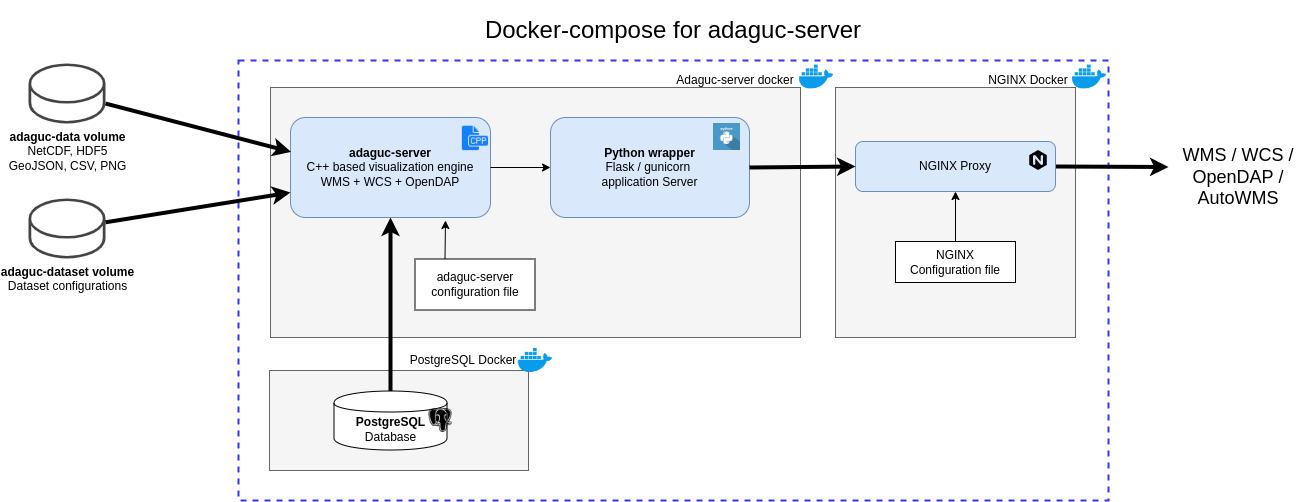The easiest way to make use of the adaguc-server is via docker containers. Docker images for the adaguc system are hosted at dockerhub. The required docker containers can be started with docker-compose. The docker compose file can be found in the Docker folder. Detailed instructions can be found below.
Adaguc comprises the following components run in separate containers:
- adaguc-server
- adaguc-viewer
- nginx webserver
- postgresql database
The most important directories are:
- adaguc-data: Put your NetCDF, HDF5, GeoJSON or PNG files inside this directory, these are referenced by your dataset configurations.
- adaguc-datasets: These are your dataset configuration files, defining a service. These are small XML files allowing you to customize the styling and aggregation of datafiles. Datasets are referenced in the WMS service by the dataset= keyword.
- adaguc-autowms: Put your files here you want to have visualised automatically without any scanning. Go to the /autowms endpoint to see its contents.
git clone https://github.com/KNMI/adaguc-server/
cd adaguc-server/Docker
Step 2. A script is available to generate the required .env file with the directories needed for docker-compose:
# Generate environment for adaguc:
export ADAGUCDOCKERHOME=${HOME}/adaguc-docker
bash docker-compose-generate-env.sh \
-a $ADAGUCDOCKERHOME/adaguc-autowms \
-d $ADAGUCDOCKERHOME/adaguc-datasets \
-f $ADAGUCDOCKERHOME/adaguc-data \
-p 443
# You can view or edit the file ./.env file
docker compose up -d --build && sleep 10
For example with firefox:
. .env && firefox ${EXTERNALADDRESS}
Note: The server runs with a self signed certificate, this means you get a warning. Accept this warning and add the exception.
If you now see the viewer, you have succesfully started the adaguc-server.
Scan with the adaguc-server container:
docker exec -i -t my-adaguc-server /adaguc/adaguc-server-updatedatasets.sh <optional datasetname>
The docker-compose-generate-env.sh tells you where you services can be accessed in the browser. Alternatively you can have a look at the ./adaguc-server/Docker/.env file
cat ./adaguc-server/Docker/.env
The webservices should now be accessible via :
https://<your hostname>/
or, if you specified a port other than 443
https://<your hostname>:<port>/
Note:
- The first time you acces the service, your browser will show a warning that there is a problem with the certificate. Make an exception for this service.
docker logs -f my-adaguc-server
docker compose down
To check what folders you have assigned to the adaguc-server container, easiest is to look into the .env file in the Docker folder:
cat .env
# outputs:
ADAGUC_DATA_DIR=/home/plieger/adaguc-docker/adaguc-data
ADAGUC_AUTOWMS_DIR=/home/plieger/adaguc-docker/adaguc-autowms
ADAGUC_DATASET_DIR=/home/plieger/adaguc-docker/adaguc-datasets
ADAGUC_PORT=443
EXTERNALADDRESS=https://plieger-dell/
Note: The directories on your computer are always mapped to the same directories in the docker container. This ensures that configuration files are interchangeable between systems.
Inside the docker container, ADAGUC_DATA_DIR is always /data/adaguc-data, ADAGUC_AUTOWMS_DIR is always /data/adaguc-autowms and ADAGUC_DATASET_DIR is always /data/adaguc-datasets.
A tip to list the actual contents in the docker container is to do:
docker exec -i -t my-adaguc-server bash -c "ls -lrt /data/adaguc-data"
docker exec -i -t my-adaguc-server bash -c "ls -lrt /data/adaguc-datasets"
